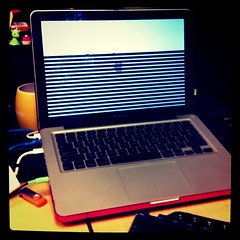Murphy's Law states: "Anything that can go wrong will go wrong." This is especially true and especially painful when there is an audience involved.
|
In his post “How To Recover From A Speaking FAIL,” Tom Webster recounts a typical story of hardware failure, offers some thoughtful recovery advice, and still manages to coin my new favorite neologism: “laptopocalypse”.
I gave a keynote right before lunch on how to think about data, and I was rolling right along when all of a sudden, exactly halfway through, my MacBook Pro crashed. Hard. Spinning-beach-ball-of-death hard. With 45 slides left to go. I won’t say I was “unfazed†but I hope I was unflappable. I’ve been standing up in front of clients and audiences for over 15 years, and let me tell you–something always happens, especially when you are doing client presentations, where you don’t necessarily have any support or backup.
I was humbled and grateful for all of the positive tweets I received during the speech for how I handled the laptopocalypse (I finished the story from the section I was on and took a few questions while I put a backup laptop online and got my slides off a USB stick) but it certainly wasn’t my natural reserves of cool that got me through it. It was training and practice. Learned behaviors. Since this sort of thing is bound to happen to you if you present in any capacity, I thought it might be useful to share exactly
And here’s another great point:
I will admit to being a little “nonplussed†when I see a speaker have a tech fail and then call for A/V because they are “no good with these things.â€

The difference between being good and excellent is one tiny extra detail — Damn, I Wish I’d Thought of That!
We travel around the country with extra suitcases full of 200 pounds of things that we might need. Things that might save the day. Zip ties, 5 types of thumb tacks, 6 kinds of tape, a hair dryer, chocolate, batteries, etc.
At our last event, the door to the auditorium was squeaking loudly. Enough to ruin the keynote.
Audio Disasters & How to Prevent Them — Viktorix
Without question, the biggest problem I face as a presenter is dealing with the unique audio issues of each venue.
Larger events will have a dedicated audio engineer, but for many events the planner is stuck with the “house†sound system or perhaps is bringing his or her own portable system to a company conference room. In either case, things can go horribly awry. It’s not that anyone is being unprofessional, it’s just that audio is intrinsically hard. I’ve learned to simply expect audio disaster, as that gives one the best chance of avoiding it. There are many varieties of audio disaster, so we shall break them down to: batteries, feedback, wires, clips, hot mics, and “potpourri.â€
This is not what I wanted to see this morning… — Betsy Weber

Twilight Zone — Rachelle Gardner
Thursday I flew to North Carolina for a conference. During my flight I was using my laptop to tweak my PowerPoint and my handouts for my workshop. When I got to the hotel and powered up my laptop, the OS refused to boot. I had a black screen with blinking cursor.
I called my tech guy. We ran the computer through a bunch of diagnostics. We tried everything to shock it back to life. No go. There was a tech guy at the conference who was running all the A/V. He worked on my laptop awhile, gave it his best shot. He couldn’t get it to boot either.
Finally I had to let that go, borrow a laptop, recreate my PowerPoint and handouts, and be ready for my workshop on Saturday morning. No problem, everything went great. (I’d neglected to bring a flash drive with my presentation on it as a backup. That’s the last time I make that little mistake.)
Worship Confessional 07.13.08 — WorshipSource
Don’t you love it when the sound system wigs out? It’s so awesome. I’ve been around church music world my whole life, and I’ve heard the statement “there’s demons in the sound board” about a million times, but today I think God did it.
Projector problems (Media-savvy’s Blog) – "A group was giving a presentation and they wanted to show a video. The sound was working, but the video would only show up on their laptop screen, not on the projector. We (the audience) could see the media player, but the rest of the “screen” was black. Did you ever experience the same? What is the problem here? How could it be solved?" [I suggested that they make the projector the primary output. Any other ideas?]
When the speech hands you lemons… – The Eloquent Woman – I arrived and learned that the room booked for the event was under construction, a fact omitted from all the booking conversations the organizers had had. (They'd in fact learned of it just within the hour.) The only available space was essentially a storefront space in the same building, nearly too small for the group, with tables and chairs packed in tight rows, and windows to the street so any passerby could watch us, if they cared to. Forget great lighting, and think street noise. Unlike the original space, this room also lacked a lectern, microphone, or projection. (Yes, I had slides.) … We'd planned to videotape the presentation, which involved putting a lavalier mic with a very long cord on me and putting the videographer in one of the storefront window bays. … There’d been just enough notice of the room change that an organizer was able to bring a projector from his office, and it wasn’t quite compatible with my laptop…
|

